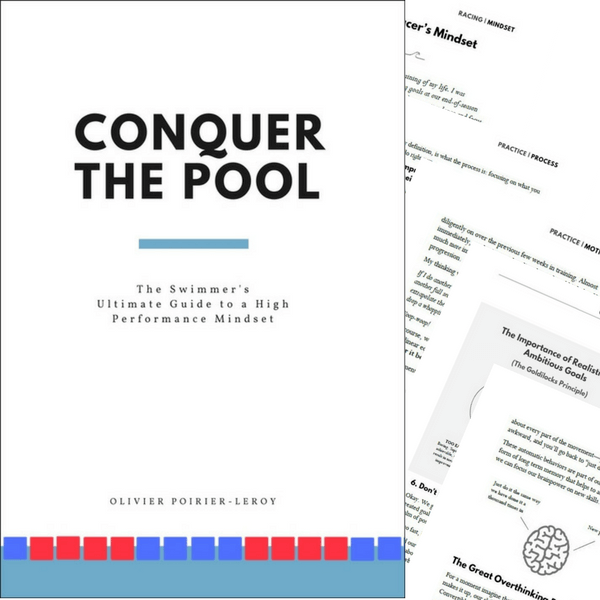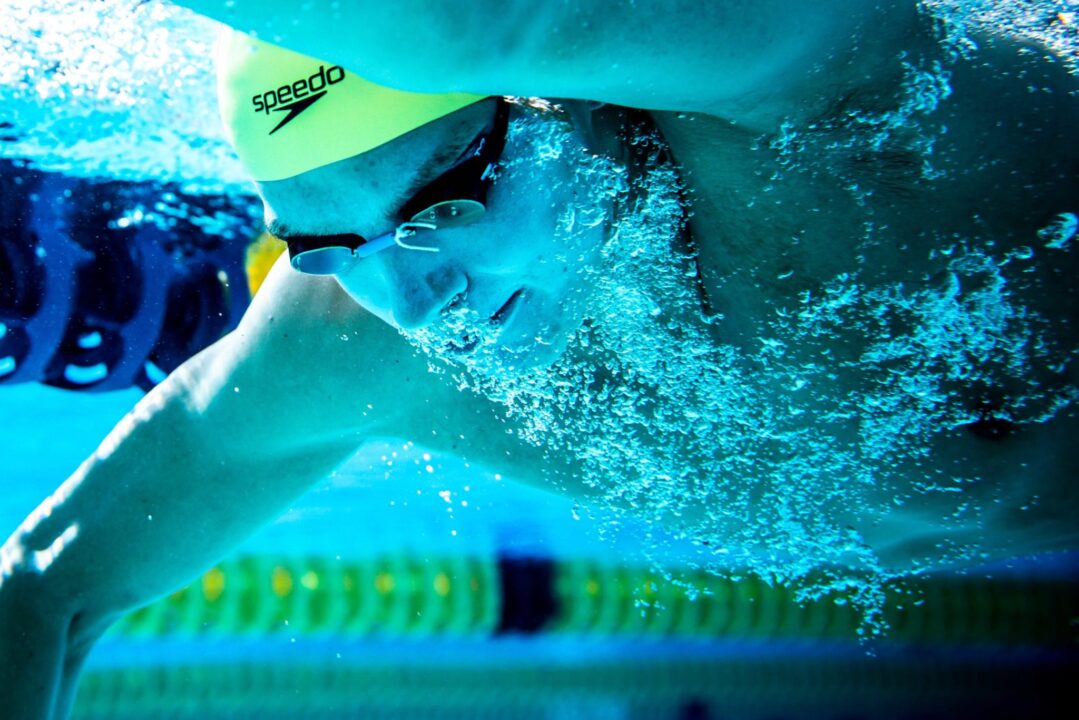Going to practice feeling like a struggle? Here are some proven strategies and tips to conquer today’s swim practice, even though you might not be feeling it.
Even the most committed swimmers in the pool have days when motivation is hard.
Yes, even the Olympic gold medalists, the world champions, the NCAA record-busters…
Like the rest of us swimming mortals, they have moments where the last thing they want to do is hit the pool for the day’s swim workout.
On days where the resistance is more resistancey than usual, here are some proven and powerful tips for how to get your butt to the pool and get some high-quality work done in the water.
1. Build a list of “yes” goals.
Small, small goals are the secret sauce to building the momentum necessary to do hard things.
Goals so small that it’s impossible not to say yes.
Especially on days when you just aren’t feeling it.
Here’s how to yes your way to completing a banger of a swim practice:
- Can you pack your swim bag? Yes.
- Can you drive to the pool? Yes.
- Can you get changed into your swimsuit? Yes.
- Can you commit to just doing the warm-up? Yes.
- Can you do the first rep of the main set? Yes.
- Can you do one more rep? Yes.
- How about one more? Yes.
- Repeat as necessary.
The more of these little “yes” moments you rack up, the more momentum you build, the more energy you create, and the “easier” it becomes to tackle more difficult stuff in the pool.
Days when we don’t feel like going to swim practice is essentially a negotiation with our worst impulses: to give up, to avoid the hard work, to choose the easy path.
Chasing small yesses is a killer negotiation tactic that saps the power of moments you don’t feel like going to practice.
2. Lock in on a competitive mindset.
What do you notice when you compare your mindset before swim practice and before racing at a swim meet?
Well, for most of us, getting fired up to race in competition comes naturally.
After all, we are shaved and tapered, the pressure is on, high-energy tunes are blasting from the PA system, the nerves are firing, and the atmosphere is thick with excellence and personal best times.
In the drowsy moments before a random morning swim practice halfway through the training cycle?
Not so much.
Swimmers tend to view training with a low-intensity mindset. This is fair—approaching each practice with a full-max mindset can be difficult to sustain.
But there are things you can steal from your competitive mindset to help boost your motivation and mindset before those mid-season swim practices.
Things like:
- Setting goals for the practice.
- Visualizing a great performance during the main set.
- A high-BPM playlist that gets the motivational juices and the feet tapping.
- Doing the pre-practice activation routine with full focus.
- Fuel yourself like the practice is a session of finals at the Big Meet.
Locking in with a competitive mindset more frequently—and not just saving it for swim meets—helps you become more effective at using it and makes it second nature and more reliable when the pressure is really on.
3. Change the goals.
Lapses in motivation can often result from the double-whammy of feeling sluggish combined with the pressure of not living up to our standards or expectations in the pool.
Another trick for days when you don’t feel like going to training, similar to setting smaller goals, is changing your goals for the swim workout to remove the pressure that can cause motivation to crash.
Instead of focusing on going to the pool and working hard or achieving a specific pace or result, the goal could be swimming with great technique. Subjective goals like “swimming with killer technique” can help remove the motivation-sapping pressure of outcome-based goals and open the door to improved performance.
“I try to make the good days great and take something positive from the days I’m not feeling good–work on technique or something like that.”
Katie Ledecky
Sounds like a meaningless difference, but managing the perceived effort ahead can help reduce the self-inflicted pressure that generates those feelings of not wanting to train today.
And sneakily enough, when we swim with great technique, fast swimming seems to happen organically.
4. Warm-up.
No, I’m not talking about the pool warm-up. I’m talking about moving around, doing some arm and leg swings, doing some light core work at home, or going for a walk.
Things you can do to generate movement, enhance blood flow, and build physical momentum.
On days when I’m feeling sluggish or unmotivated, I have found a lot of success with warming up at home or in the gym, where I can blast the aforementioned high-BPM playlist and warm up faster (compared to a cold swim pool) and hit the pool warm, both physically and mentally.
Some research backs this up, showing that just three minutes of light exercise can increase energy and motivation.
According to a study published in the Journal of Science and Learning, three minutes of low-intensity aerobic exercise significantly increased feelings of vigor and reduced fatigue compared to a control group that sat on their butts for twenty minutes.
In other words, movement creates motivation and reduces feelings of lethargy, even if it consists of low-intensity movements like walking, arm swings, and other “slow aerobics” exercises.
Build up a light sweat outside the pool, and you’ll find it easier to hit the water on days when you are struggling to get motivated to dive in.
5. Collect the good “bad” days.
One of the biggest realizations I had as a young athlete was that how I felt before practice was rarely a good prediction of how the swim practice would go.
Even more recently, during the summer, when I committed to doing as many sprint 50s as humanely possible, there were days when I busted out with a surprise breakthrough even though prior to the workout, my mindset was, well, less than awesome.
Showing up, working through those feelings of resistance, and being patient enough to see the workout to completion turned what felt like should be a bad day into a breakthrough day.
It’s crucial that you collect these moments to remind yourself that you don’t have to feel perfect or even great to have a productive swim practice.
(And yet another reason why swimmers should log their swim workouts, including how they felt before and during the workouts so that they can properly contextualize future moments of “not feeling like it.”)
Think back to the times when you weren’t feeling so hot or your mindset wasn’t perfect at the beginning of practice…
And by the end, you’d not only put together a good practice but also surprised yourself with just how much excellence you’d cobbled together even though you weren’t ultra-motivated.
Collect the bad-to-good days, either in a journal or in your logbook, and keep them close for days when you aren’t feeling like training.
6. Crank up the intensity.
Want to zap feelings of not feeling it? Throw some intensity and energy by front-loading your swim workout with high-intensity swimming.
I know, this sounds a little counter-intuitive…
But often, the fastest way through feeling demotivated is to swim through it.
- Strap on some fins and paddles and hammer out some fast 25s.
- Do an effort 50 off the blocks.
- Strap on a swim parachute and swim a bunch of 25s fast with lots of rest.
High-intensity exercise can have an almost immediate impact on mood compared to longer, lower-intensity exercise (Vella et al., 2017).
By flooding the body with endorphins and neurotransmitters like dopamine and serotonin, you can shorten your way to “feeling like it” faster than longer, steady-state swimming.
On days when I’m tired and not in the mood to spend 90 minutes in the water, front-loading my workout with high-energy swimming can help me regain my mood and motivation.
You can literally shake off the feelings of demotivation or shoot them with a high-energy laser (Pew! Pew!).
Don’t get me wrong: Long, low, and medium-intensity swimming have their respective benefits. However, they are also fertile ground for swimmers already feeling demotivated to brood further about their perceived lack of enthusiasm.
High-intensity effort swimming requires more focus and your full attention, which can help swimmers move beyond ruminating on feelings of fatigue or feeling demotivated.
Of course, before hammering out full effort, err, efforts in the pool, make sure you always complete a thorough warm-up.
Wrapping Things Up
The key thing to remember is that we ALL experience these drops in motivation.
Swimmers, especially, with long, seemingly never-ending seasons and weeks of training where we swim more meters than we drive.
Michael Phelps had days when he didn’t want to train, Caeleb Dressel had days when things didn’t click, and Katie Ledecky even had “bad” days in the pool.
It’s natural. Normal. It’s okay.
Which is the first step in making the best of them when they do happen.
And separate yourself from the swimmers who let those feelings get the best of them.
In sum, you should:
- Remember that there will be moments when the last thing you want to do is go to the pool.
- Use micro “yes” goals to help build momentum.
- Practice using a competitive mindset to increase your arousal state.
- Switch up the focus of the practice to encourage increased performance.
- Warm up and use movement to increase motivation.
- Collect moments where you demonstrate excellence on “bad” days.
- Increase the intensity early in the training session.
Use these tips and strategies and make the bad days hilariously good.
See you in the water!
ABOUT OLIVIER POIRIER-LEROY
Olivier Poirier-Leroy is a former national-level swimmer, author, swim coach, and certified personal trainer. He’s the author of YourSwimBook, a ten-month logbook for competitive swimmers.
 He’s also the author of the recently published mental training workbook for competitive swimmers, Conquer the Pool: The Swimmer’s Ultimate Guide to a High-Performance Mindset.
He’s also the author of the recently published mental training workbook for competitive swimmers, Conquer the Pool: The Swimmer’s Ultimate Guide to a High-Performance Mindset.
It combines sport psychology research, worksheets, anecdotes, and examples of Olympians past and present to give swimmers everything they need to conquer the mental side of the sport.
Ready to take your mindset to the next level in the pool?
Click here to learn more about Conquer the Pool.
